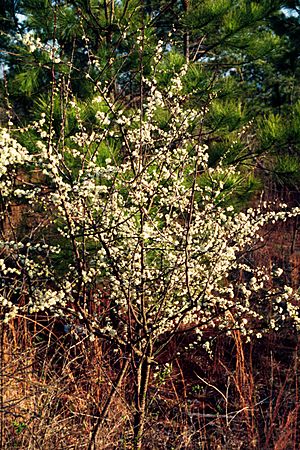Prunus umbellata facts for kids
Quick facts for kids Prunus umbellata |
|
|---|---|
 |
|
| Prunus umbellata bush | |
| Conservation status | |
| Scientific classification | |
| Genus: |
Prunus
|
| Species: |
umbellata
|
| Synonyms | |
|
List
Prunus mitis Beadle
Prunus tarda Sarg. Prunus umbellata var. tarda (Sarg.) W.Wight Prunus injucunda Small Prunus injuncunda Small |
|
Prunus umbellata, also known as the flatwoods plum, hog plum, or sloe plum, is a type of plum tree. It grows naturally in the United States. You can find it from Virginia in the east, all the way south to Florida, and west to Texas.
This plum tree can grow quite tall, reaching about 20 ft (6.1 m) high. It can also spread out to about 15 ft (4.6 m) wide. Its leaves are green and have small, saw-like edges. In the autumn, these leaves turn a pretty yellow color.
The flowers of the flatwoods plum are usually white, creamy, or a light gray color. After the flowers, the tree produces round, purple fruits. These fruits are small, about 0.5–1 in (1.3–2.5 cm) across.
About the Flatwoods Plum
Prunus umbellata trees can live for a long time, sometimes up to 40 years. It can be tricky to tell them apart from another plum tree called Prunus angustifolia. This is because they can easily mix together and create new types of trees.
When Do They Grow?
These plum trees bloom and produce fruit later in the year compared to other plum varieties. The fruits usually become ripe between August and October. However, you won't see a lot of fruit every year. Big crops of plums only appear every 3 to 4 years.
What Are the Fruits Used For?
Even though they are small, the fruits of the flatwoods plum are often used to make tasty jellies and jams. People enjoy turning these wild plums into sweet treats.
Images for kids




